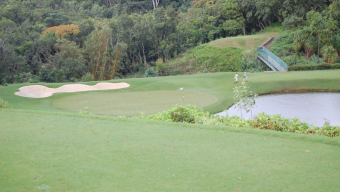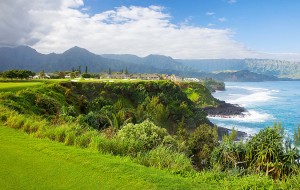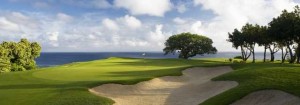PRINCEVILLE, Hi. – The approach to Makai’s picturesque third hole begins well back on the No. 2 tee, the long view down a sublime grassy passage with the churning Pacific, the graceful St. Regis Hotel and the rugged peaks along the Hanalei coast and Bali Hai in the distance.
Once you put down a crooked number from the arrow-straight par-5, 611-yard second hole, you continue to walk toward the sea a few more yards and peer over a bluff to the 181-yard par-3 third, one of the great par-3s not just on this course, or not just on this island but in the whole archipelago.
It’s one of four quality par-3s on Makai’s 1971 Robert Trent Jones, Jr. design – and redesign (2009-10). It’s a breath-taker (pictured above).
At eye level, you can see the wide opening over the palm trees to the Pacific, the distinctive white hotel and the nearby stilt houses with their balconies precariously hanging over the canyon edge.
It’s about an 80-foot drop to the green, with half your landing area grass and half water (not recommended). There’s a large lake to the green’s right and any hint of a wrinkle in your trajectory or a puff of wind will make your ball disappear in the drink forever. Covering half of the front entry of the green is an ample bunker and another large one in back.
As a further deterrent, you can’t drift much to the left because of unforgiving vegetation along the canyon wall and anything over the green and hill in back has no hope for salvage.
All you have to do is hit it straight then account the elevation change and the ever-present wind, which means most times you actually club up. The starter might even tell you two or three clubs up.
“The wind typically is always here,” said Ryan Forster, Makai’s director of golf. “The course definitely is set up for the trades (winds) … Mainland wind is nothing compared to here, where you are dealing with 15-to-20 mph winds just about every day.”
Those winds, mighty at time, won’t help you deal with the other three par-3s, all at least 200 yards long from the back tees. Most of us would be advised to move up – where we belong. The course has four tee positions. Pick the one best for you, black (7,223 yards), blue (6,496), white (6,134) and red (5,466).
Your next par-3 is the 213-yard (173 from the blues) seventh hole. It’s so long you have to hit over an ocean.
The seventh tee is on a land spit as you tee off with your back to the Pacific. A wide canyon, with the foaming surf below, needs to be cleared to large green that is protected front, left and back by bunkers. The green has a dip on the right side that, if the pin is below, you have a chance to snuggle the ball pretty close if you can catch the slope.
Then the fun continues at the 13th, a par-3 yet it’s 255 yards from the back tee – generally into the wind. You might need a Howitzer hybrid from there. Just about everyone needs to move up, 198 from the blues or 175 from the whites. It’s still a beast, and you have to make it up to the flat area near the green or the ball will trickle left down a slope and into the thick stuff. Bunkers top and bottom also are trouble. It’s the No. 3 handicap hole.
Before we take you to the final par-3, here’s a message for the big hitters. The next hole, the par-4, 338-yard 14th, could be considered the ‘fifth par-3’ for the mighty swingers.
Guys who can crush have the opportunity here to go for it because the wind generally blows from behind. Once the drive clears the traps – about 60 yards from the green, a hard, accurate bounce in front of the green can put you on the surface.
The final par-3 is the 16th, a straight-forward 202-yard shot from an elevated green to an elevated green. The biggest issue here is a yawning bunker to the left of the green.
The quartet of par-3s is diverse with some water hazards, wind issues, thick rough and strategically placed bunkers. But the common thread for all four is distance. And plenty of it. You’ll need the long sticks for the short holes.























